How to Get Information About Your Old Wooden Canoe
June 24, 2018
by Mike Elliott, Kettle River Canoes
email: artisan@canoeshop.ca
Fundamental to any canoe restoration is understanding what you are dealing with. This blog examines a number of ways to answer some basic questions:
1) Who built my canoe?;
2) When was it built?;
3) How was it built?;
4) What supplies and materials were used? and;
5) What did it look like originally?
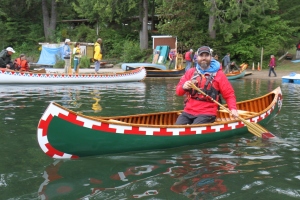
Mike Wootton asked the WCHA about his Old Town canoe. It was built in 1937 and was shipped to Portland, Maine. The decks, thwarts and seats are oak, the gunwales are spruce and the canvas was painted dark green. He added the Old Town design number 1 as a finishing touch. He then showed it off at the 2016 spring meet of the Northwest Chapter of the WCHA.
WCHA – The first place I go for information about a new restoration project is the Wooden Canoe Heritage Association (http://www.wcha.org). They are an amazing resource. One of the things they do is to host an on-line forum. When you ask a question, there are often several people quick to respond with help, advise, guidance and historical information.
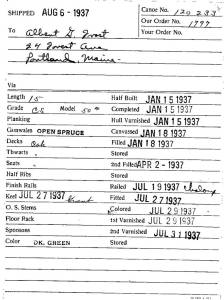
Mike Wootton asked the WCHA about his Old Town canoe (serial number 120233). They sent him a scan of the original build record. He used the information to complete the restoration.
Part of the forum is a build record search. They have archived a complete collection of Old Town, Carleton and Kennebec canoe company build records. If you have the serial number from your canoe, they will send you a scan documenting when it was build, the model, colour and style as well as to whom it was shipped.
Canoe Museums – The Canadian Canoe Museum in Peterborough, Ontario houses a collection over 600 vintage canoes and kayaks from around the world.
In addition, they house a large archive of canoe-related documents. It is worth becoming a member and spending the time to dig through their collections for the information you are looking for.
Another source of information is the Wisconsin Canoe Heritage Museum in Spooner. It has a small, yet comprehensive collection of primarily American-built antique canoes.
Both of these museums include workshop facilities and run regular classes teaching canoe restoration techniques. They can also connect you with canoe restorers who have experience dealing with specific types of antique canoe.
It is also worthwhile to venture into every small museum and gallery you come across in your travels. Old canoes often create a focal point in community collections. When you find a canoe you are looking for, ask the curator for permission to measure the canoe and take notes on its construction.
On-Line Searches – Once you know the make and model of your canoe, it is often helpful to enter those words into on-line search engines. You never know what may happen to be available for a week or two. Written articles, blog posts and images from boat shows (to name a few) will be available on-line for a limited time. Check on a regular basis to see what is newly posted. Also, see what is being sold on ebay. There may be a listing for exactly the same canoe you are working on. Canoe catalogues are also sold regularly on ebay. If your canoe is an Old Town, and you known the year it was built, it is possible that the catalogue for that year is being sold on-line.
Catalogues – As you begin to plan your restoration, the canoe catalogue for your make, model and year can often provide a wealth of specific information about how your canoe was constructed, the woods used for the various components and perhaps examples of decorative designs painted on the canvas.
The WCHA has developed an impressive collection of historic canoe company catalogues for sale. From their on-line store, you can buy reprints of a wide variety of vintage canoe company catalogues (both Canadian and American). Large collections are also available on USB memory drives. These include: 1) a collection of 73 catalogues from 12 Canadian companies; 2) a collection of 50 Canadian and American companies; 3) a collection of every page of every Old Town Canoe Company catalogue from 1901 to 1993 and; 4) a collection of Thompson Brothers catalogues from 1907 to 1970.
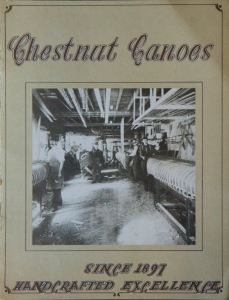
The front cover of the 1978 catalogue for the Chestnut Canoe Company. My client designed the catalogue which turned out to be the last one ever produced.
The Last Chestnut (How research helped bring a canoe back to life) – In 2006, a client came to me with his Chestnut canoe which was in desperate need of restoration. He designed the 1978 catalogue for the company. When asked what he wanted in terms of payment, he requested they build an Indian Maiden canoe for him.
It had been almost 20 years since they last built that model. They found the building form buried in mud behind the factory. They rebuild it and decided to build a special edition series of 300 canoes. They worked out the process by building a prototype and then built the canoe for my client (a special plaque on the bow identifies it as 001 of 300). He took possession of the canoe directly from the factory in December 1978 and they closed the doors behind him. They were out of business.
When the canoe arrived in my shop, many components were missing and I had never seen another like it. In an on-line search, I found an article from the University of New Brunswick talking about a canoe that had been hidden away in the basement of a building on campus. The article identified it as a Chestnut Indian Maiden built in 1978. The university had just donated the canoe to the Wild Salmon Nature Centre in St. Andrews by-the-sea, NB.
My sister and her husband live in Maine about two hours drive from St. Andrews. I told them about my project and asked them to collect dimensions for a number of components on the canoe. They readily agreed and took on the research project as only two wildlife management PhD’s can. A couple of weeks later, I received a package full of photos, measurements, drawings and notes.
My restoration concluded successfully thanks to lots of research.
After publishing the story, I received an email from someone in Toronto. His brother had seen the Indian Maiden on display at the Canadian National Exhibition in the fall of 1978. Apparently, he was the only person to order one. The plaque on the bow identifies it as 002 of 300. To my knowledge, it is the last canoe ever built at the factory.
The entire canoe restoration process is described in my book – This Old Canoe: How To Restore Your Wood Canvas Canoe.
If you live in Canada, CLICK HERE to buy the book.
If you live in the USA, CLICK HERE to buy the book.
If you live in the UK, CLICK HERE to buy the book.
Si vous habitez en France, CLIQUEZ ICI acheter le livre.
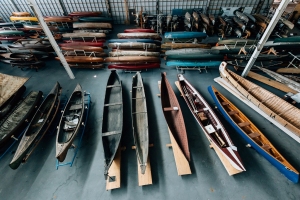
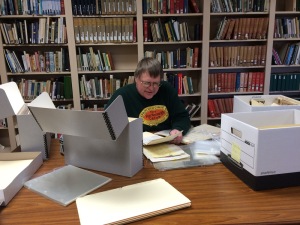
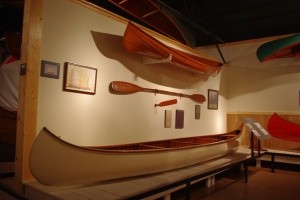
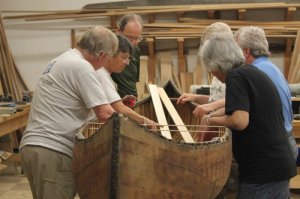
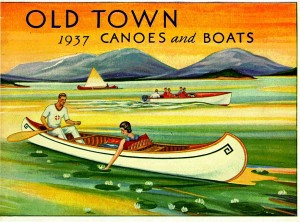
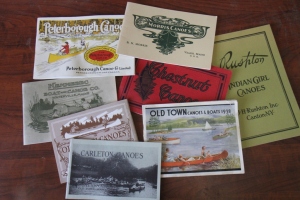
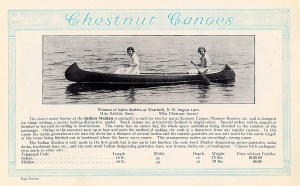
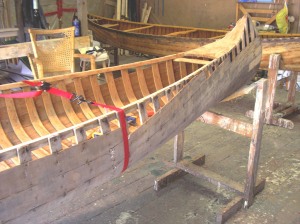
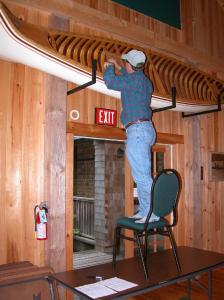




June 18, 2021 at 10:27 pm
Hello great article! I’m looking for information as I’m going to sell an old wooden canoe my dad (83 year old) had hanging for years in his back yard. It has these seats you describe as Rawhide Babieche. Where do I find the serial number for this canoe? The coating/covering on the canoe has worn off, so just the wood is exposed.
June 19, 2021 at 2:32 pm
Thanks for the question. Canoe seats laced with rawhide (babiche) are usually found in Canadian-built canoes. Very few of these canoes had serial numbers and none of them kept build records. It is very difficult to determine age or other specifics. The covering is canvas stretched over the hull. When it rots along the edges, it just falls off the canoe (not glued on).
June 20, 2021 at 12:02 am
THanks very much! I really appreciate your reply and this information. You (and your site) are an encyclopedia of canoe knowledge! Very valuable, I’m currently reading through several pages…
Wishing you good health. Thanks 🙂